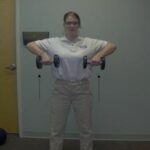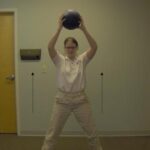Rotator cuff injuries vary from simple inflammation of the muscles in the shoulder to a complete tear that needs surgical attention. The rotator cuff is comprised of four muscles in the shoulder, named the subscapularis, supraspinatus, infraspinatus and teres minor. This quartet of major muscles, along with their tendons, connects the upper arm bone known as the humerus with your shoulder blade. They also serve to keep the ball of your upper arm bone securely in your shoulder socket. Your rotator cuff allows the shoulder to have the farthest range of motion of any of your joints, making an injury to it that much more serious. Rotator cuff injuries are not unusual, especially among athletes and laborers, and the treatments for them have advanced greatly in recent years.
There are different types of rotator cuff injuries. Tendonitis is one, where the tendons in the rotator cuff become inflamed when they are overused. This happens often in the case of athletes, tennis players and baseball pitchers for example, who repeat the same motion that strains these tendons repeatedly. Bursitis, where the bursa sacs that are filled with fluid in your shoulder to prevent friction become irritated and swollen, is another common rotator cuff problem. A rotator cuff tear can develop when the tendons weaken and then degenerate; an acute tear can happen during a fall, as you reach out to cushion the impact, or while attempting to lift or pull something beyond your means. A chronic tear comes about over time, as repeating the same motion eventually wears down the tendons in the region. Even in non-athletes, after the age of forty your rotator cuff can break down from the rigors of everyday life. Arthritis can creep into the area, and bone spurs can annoy your rotator cuff, precipitating great discomfort when you attempt to raise your arm.
In some instances, bad posture can lead to a rotator cuff injury, as slouching repeatedly can cause a tendon or muscle to get pinched beneath the shoulder bones. Whatever the reason behind your rotator cuff pain, you will realize there is a problem when symptoms such as shoulder weakness, loss of range of motion, and sharp pain occur, especially when you try to reach behind your back or over your head. Sleeping on the side with rotator cuff pain will not be comfortable, if possible at all, and you will feel discomfort when you try to lift or pull anything of any size. Simple acts such as putting on your shirt or brushing your teeth will result in pain with a rotator cuff injury, and a really serious one will find the person with it constantly hurting.
If you play a lot of sports that require overhead motions like baseball, tennis, or basketball, or if you make your living in one of the high risk occupations for rotator cuff injuries, jobs such as painters or auto mechanics working under lifts all day, and begin to feel that constant pain in your shoulder, you should see your doctor. If you have these symptoms after a fall or after trying to lift something heavy, it is also advisable to get your shoulder checked. Men over forty are at the age where wear and tear could be the culprit, and women over thirty-five are in the high risk group for tendonitis. Your doctor will take X-rays to determine if you have a rotator cuff injury, with an MRI or an ultrasound also possible to reveal the extent of the damage to the shoulder muscles and tendons. An arthrogram is a prospect as well, where dye is injected into the shoulder before an X-ray, enhancing the image.
Physical therapy will be the first thing that your doctor considers for a rotator cuff injury, hoping to heal it in that manner with specifically designed exercises. However, if this is deemed not enough to correct a rotator cuff injury, then steroid injections will be considered to reduce inflammation and pain. Large rotator cuff tears may need surgery, either with open surgery or arthroscopically, employing the aid of a minute camera inserted through an incision. Complete recovery from rotator surgery nowadays is the norm, but the procedures available now were unheard of even thirty years ago. Rotator cuff injuries often meant the end of someone’s pitching career, as was the case with the great Dodger right-hander Don Drysdale. Had Drysdale’s injury occurred today, instead of in 1969, he would have been able to have an operation and be back on the mound at full strength in less than a year.
It is possible to deal with a minor rotator cuff injury at home, with rest being vital for the shoulder in question. No heavy lifting or overhead motions for five to seven days should be sufficient. Icing the shoulder can alleviate swelling and aching; a cold pack for fifteen minutes at a time every couple of hours for a day or two after the injury occurs. After the icing phase has been completed, apply hot packs or a heating pad for twenty minutes at a time periodically until the pain has stopped. Over-the-counter pain products such as Motrin and Advil may help the situation. Remember that total inactivity for your shoulder can have stiffness as a consequence, and if you favor the affected shoulder too much, a “frozen shoulder” can occur, where it is so stiff that it is almost impossible to move it. If these measures fail to produce satisfactory results, then you may need to see your doctor to determine how serious your rotator cuff injury is.



